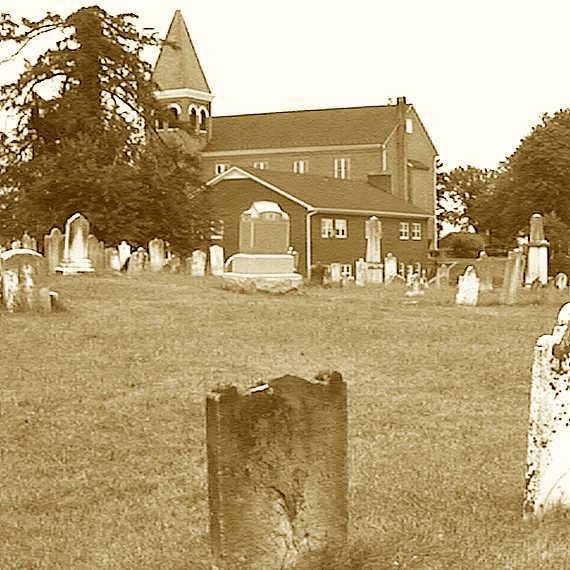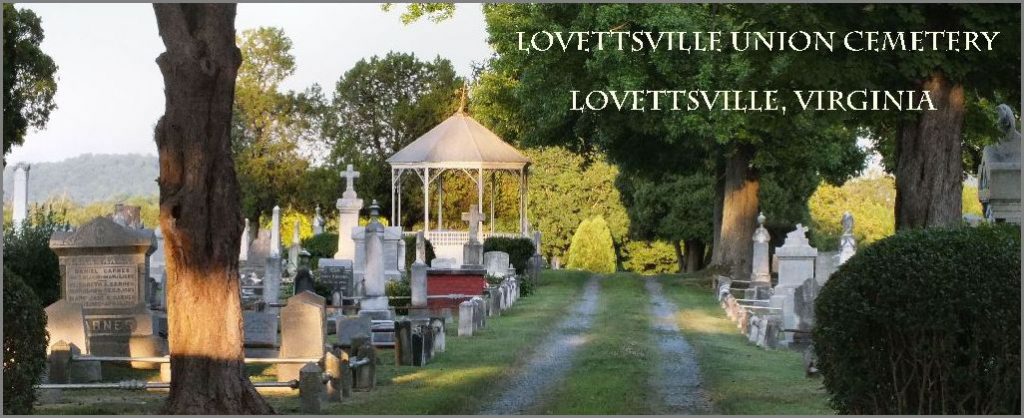New Jerusalem Lutheran Church (est. 1765), 12942 Lutheran Church Road, Lovettsville, Virginia

The two-story, front-gabled, brick New Jerusalem Church [053-0372; 255-5001-0110] was constructed in 1868, replacing an earlier church that had burned. The large rectangular building, which is Late Greek Revival style in its form and detailing, rests on a random-rubble stone foundation that is taller in the rear elevation than in the front. The exterior walls are laid in five-course American bond with the exception of the front, which is laid in stretcher bond. This highly unusual feature is also found on Freedom Hall at 26 East Broad Way [255-5005; 255-5001-0024], constructed in 1869, probably by the same builder. Brick corner pilasters run the entire height of the building and terminate in wooden trim that suggests a Doric capital. The side walls have a stepped brick cornice, while the front gable end has a wooden rake with gable-end returns. The first-floor façade has paired stained-glass windows flanking the central, double-leaf, wooden entrance doors that feature paneled reveals and a transom. The second level of the facade contains three bays of tall and narrow stained-glass windows. All openings on this level are topped by a wooden entablature. In the attic level of the gable end is a two- light circular window with a circular brick surround. According to a history of the church, the stained- glass windows date to the 1930s. The north elevation features two four-light stained-glass windows on the first floor as well as a double-leaf door topped by a four-light stained-glass transom. The second floor is comprised of four bays of tall, eight-light, stained-glass windows similar to those found on the front of the church. Window and door openings are topped by jack arches. The large, three-story, seven-course-American-bond brick tower located at the southwest corner of the church was added in 1903 and dominates the skyline in this relatively flat landscape. The first floor features date stones as well as marble tablets with names of former and present pastors of the church dating back to the earliest in 1765. Small, one-over-one-sash, stained-glass windows are located on the front and south side of the tower topped by the open belfry marked by double-arched openings on each elevation. A modillion wood cornice is at the base of the pyramidal roof, which is covered in slate shingles and topped by a gold cross (added in 1945). Entrance into the tower is at the first floor of the south elevation through double-leaf, four-paneled doors topped by a two-light transom. A one-story, nine- bay, gable-roofed brick addition extends to the side near the southeast corner of the church and was completed in 1964.
The other early group of German settlers in Lovettsville was associated with the Lutheran Church. According to the history of the New Jerusalem Lutheran Church [053-0372; 255-5001-0010], whose present sanctuary stands at 12942 Lutheran Church Road, the first building for this congregation dated to 1765 when the Reverend J. S. Schwerdfeger from Frederick, Maryland, organized a group of German Lutherans already living in the German Settlement.6 A deed dated 1797 to the congregation of

The cemetery at the New Jerusalem Lutheran Church [053-0372; 255-5001-0110], located southeast of the town limits of Lovettsville along Lutheran Church Road, contains the earliest legible grave stone among the Lovettsville cemeteries. That stone with the date 1770 is for Isaac Leuckens. The death date on that stone sets the beginning date of the Period of Significance for the Lovettsville Historic District. Associated with the Lutherans who organized here in 1765 and were among the first settlers in what became Lovettsville, the cemetery contains approximately 600 graves. According to the church history, the original church was replaced with a stone building in 1802 that collapsed in a snowstorm in 1839 and was replaced with a brick church. That church burned in 1868 and was immediately replaced with the current brick building, which was dedicated in 1869. The tower was added in 1903. The Greek Revival-style brick edifice is a strong visual landmark east of the Berlin Turnpike upon approaching Lovettsville from the south. The church and cemetery are also highly visible from the southern extent of the district.
Located next to the New Jerusalem Church is Union Cemetery [255-5001-0111], the community burial ground for the area. Occupying 16 acres, this cemetery is laid out in a grid pattern. The entrance is marked by brick gateposts from the mid-20th century and a wrought-iron fence along the front features a decorative wrought-iron arch with the words “Lovettsville Union Cemetery Incorporated Dec 19 1879” in wrought-iron letters. The cemetery contains approximately 3,600 graves and was incorporated in 1879, although there are stones from the 1840s and some earlier ones that came from New Jerusalem Cemetery. Among the organizing trustees were families long associated with the history of Lovettsville, and the cemetery contains the remains of prominent Lovettsville land owners and citizens. The historic connection of the church and these cemeteries to the story of Lovettsville is critical. The small area that lies between New Jerusalem Church and the cemeteries and the main body of the historic district is rural and open in character and does not have the characteristics of the more densely developed town of Lovettsville. However, the close and integrated relationship of these resources to the history of Lovettsville justifies their inclusion as non-contiguous resources.

Another important resource that was established following the Civil War was the Union Cemetery [255-5001-0111]. It is located at 12930 Lutheran Church Road a short distance outside the town‘s limits and just north of the New Jerusalem Lutheran Church and contiguous with the old cemetery associated with the Lutheran church where confirmed burials date to the late 18th century. Although not contiguous with the town boundaries, it is believed to be so closely associated with Lovettsville that it is an integral part of the community‘s history and the history of this district. Cemeteries associated solely with the German Reformed Church, the New Jerusalem Lutheran Church, and the Presbyterian Church were fast becoming overcrowded in the years following the Civil War, and the laying out of a new burying ground became mandatory. The official incorporation date was 1879 and its first trustees bore family names found throughout the records of the town, many of whom either lived in or near Lovettsville such as Fry, Wire, Goodhart, Virts, and Stone. There are about 30 burials that pre-date the actual incorporation date that were moved from the adjacent New Jerusalem Church cemetery, with several of the legible headstones dating to the 1840s. It was not uncommon for various denominations to share a burial ground in small communities, and the number of burials in Union attest to the important role this cemetery played in the entire region around Lovettsville. Several efforts over the years, notably in 1915, 1920, and the 1960s, plus a small stipend to pay for mowing were authorized by the Town Council, confirming public support, albeit limited.45 (Section 8, page 57).
Citation: https://www.dhr.virginia.gov/registers/Counties/Loudoun/255-5001_Lovettsville_HD_2012_NRHP_FINAL.pdf
See also Lovettsville Historic District
See also Lovettsville Historic District Listed On National Register of Historic Places
